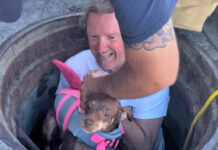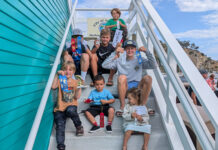Annual Avalon Harbor Underwater Cleanup celebrates its 39th year
Thirty-nine years, by nearly any measure, that’s a while. When anything lasts that long, standing up against time, it’s either built, managed, maintained or preserved well for a reason.
The Annual Avalon Harbor Underwater Cleanup is celebrating its 39th year of bringing hundreds of scuba divers from all corners of the country and walks of life to Catalina island to don their equipment and scour the seabed in search of items which have found their way there.
The program is headed up by Jill Boivin and her husband Tom Turney who, along with dozens of volunteers, including nearly every dive shop employee in Avalon all work tirelessly to pull off this yearly event.
The annual cleanup has stood the test of time for a reason, many actually. First and foremost, these volunteer divers genuinely care about marine environments which are so critically important to their undersea interests, be it a pastime or profession. Their collective efforts help ensure that Avalon Harbor remains cleaner and healthier for a multitude of living things which reside there and helps maintain appeal for visitation to the island.
Funds generated through diver participation admission fees and raffle items help support the USC Catalina Hyperbaric Chamber and the Wrigley Institute of Environmental Studies Catalina Conservation Divers.
Additionally, with a typical diver attendance rate in excess of 500 participants, the event is a fantastic social gathering event for everyone involved to reconnect with old friends, form new ones, compare equipment, engage in friendly competitions over debris collected, laugh, story tell and just have fun.
It’s difficult to definitively establish when something has become a tradition as it’s a form of recognition or status based solely on arbitrary elements, but always involving longevity. It’s safe to say that after thirty-nine years, the Avalon Harbor Cleanup is a legitimized tradition. It joins the ranks of many other diving legacies connected to Catalina Island which are over-flowing in traditions.
Catalina Island has been one of the premier diving destinations in all of North America since long before open-circuit scuba systems were introduced in the late 1940’s. Prior to that, breath-holding skin divers, or “Gogglers” and homemade helmet divers were making regular pilgrimages to Catalina as early as the late 1920’s and early 1930’s to take advantage of clear waters filled with marine life including fish, abalone and lobster which were all some of the principle reasons to get beneath the waves. In 1933, the first official diving club, the San Diego “Bottom Scratchers” was founded. All of the members of the club were breath hold spearfishermen as diving lung equipment hadn’t yet entered the scene, and these early pioneers made regular visits to the island to hunt game.
During the early 1940’s taking the plunge around Catalina might have held more somber and significant reasons. From 1942 through 1945, the Office of Strategic Services (OSS) engaged in covert diver training programs on the island designed to prepare teams of underwater combat and demolitions personnel to undertake clandestine undersea missions in conflict zones while the world was mired in global war.
Postwar, diving pursuits around Catalina settled back into a more routine activity as spearfishing, abalone and lobster hunting resume. By the end of the decade, the wartime secret Cousteau-Gagnan Aqualung ambient pressure demand regulator was introduced from France into America and almost overnight anyone with a sense of adventure and courageous constitution could strap on an Aqualung rig and become part of the undersea world.
By the early 1950’s, scuba diving had begun to establish a foothold and by 1953, just twenty years after the formation of San Diego’s Bottom Scratchers, they were joined by dozens of registered California dive clubs bringing the total up to 132.
By 1956, no fewer than eight other scuba equipment manufacturers joined the ranks with U.S. Divers-Aqualung. Amongst them, Voit-Swimaster, Dacor, Healthways, Northill-Garrett, Viking, Sportsways, and two aviation companies, Scott and Rose Aviation which were both in the business of building aircraft pilot’s oxygen breathing systems but decided to dabble in the recreational scuba industry during its infancy. All of these companies would supply the gear to enable a curious generation to see what lay below.
In January 1958, the television series “Sea Hunt” starring Lloyd Bridges as ex-navy combat Frogman Mike Nelson debuted, many of the early episodes were filmed around the island and the floodgates for scuba interest were blown right off the hinges. By its second season, Sea Hunt boasted a weekly viewing audience of 40 million adoring fans. Almost as though it were the results of a wave of a magicians wand, suddenly scuba diving had gone mainstream and California along with Catalina Island waters reflected it. in 1962, the Casino Point dive park in Avalon was established for the general public and quickly earned the reputation as a strikingly beautiful example of a classic southern California kelp forest dive and its popularity surged.
Jacques Cousteau would add to the fever as his books and “Undersea world of Jacques Cousteau” series of nature documentary films reached the living rooms of millions more American households. One of those documentaries, titled the “Night of the Squid” was filmed in 1970 in Catalina waters and inspired the next wave of underwater explorers to the island. During the early 1970’s the mysterious project “Azorian” was initiated with its CIA cover story involving Howard Hughes and his Glomar Explorer ship designed as a pseudo mining vessel for manganese mineral nodules/sunken Russian submarine recovery mission used Catalina island as part of its clandestine operations location for equipment installation and testing.
Bump forward a half decade and the first Avalon harbor underwater cleanup takes place which would set the stage for the creation of a new tradition to add to Catalina’s rich history with diving.
In May of 2017 the Avalon Diving History Exhibit (ADHE) opened to the public. The small museum is located on the ground level of the world famous Casino building, adjacent to the Casino Point dive park and contains one of the most unique and diverse collections of vintage dive related equipment in the country. Many items are the only example available for public viewing, so if you’d like to see them, they’re only available here in Avalon. The exhibit was built by divers, for divers, so please, by all means, drop by.
Catalina’s diving history continues to build as recent dive related events around Catalina island like NASA’s NEEMO astronaut training program which operated out of the Wrigley Marine Institute in the summer of 2019, and over the past few months, various underwater film crews worked with local dive operations and their personnel to capture underwater sequences for upcoming nature documentaries which also contribute to the island story.
So this weekend’s 39th annual Harbor cleanup is just the latest installment that will add to Catalina Island’s rich history and connections with undersea exploration, adding to a long legacy steeped in traditions.
To all those participants of the harbor cleanup, past, present and future, you are helping form a portion of those diving traditions and a grateful community here in Avalon extends a deep and sincere thank you for taking the time, expense and diving skill to help insure that Avalon will remain a destination which retains its allure.
Thank you, dive safe, and above all, have fun.











